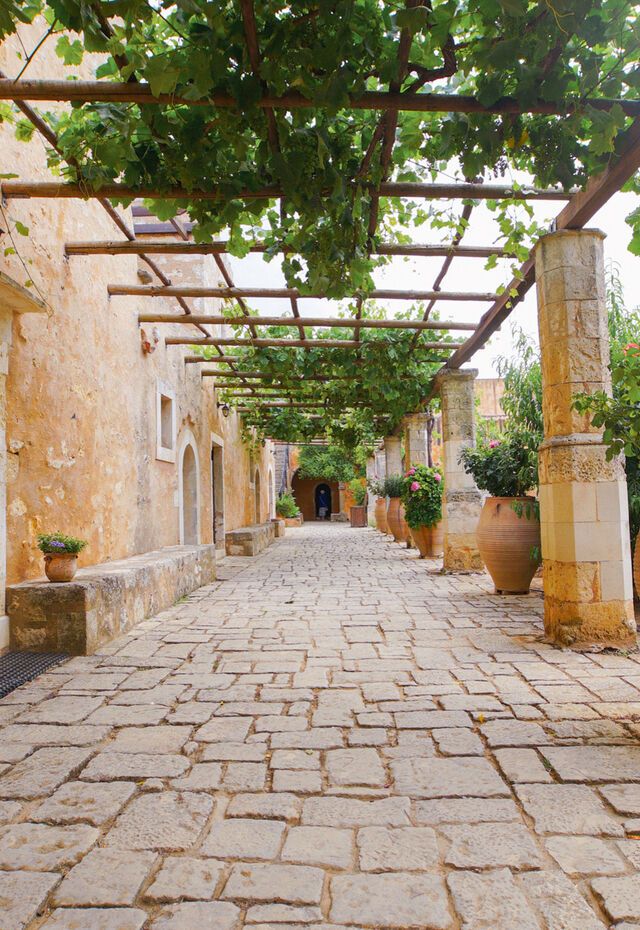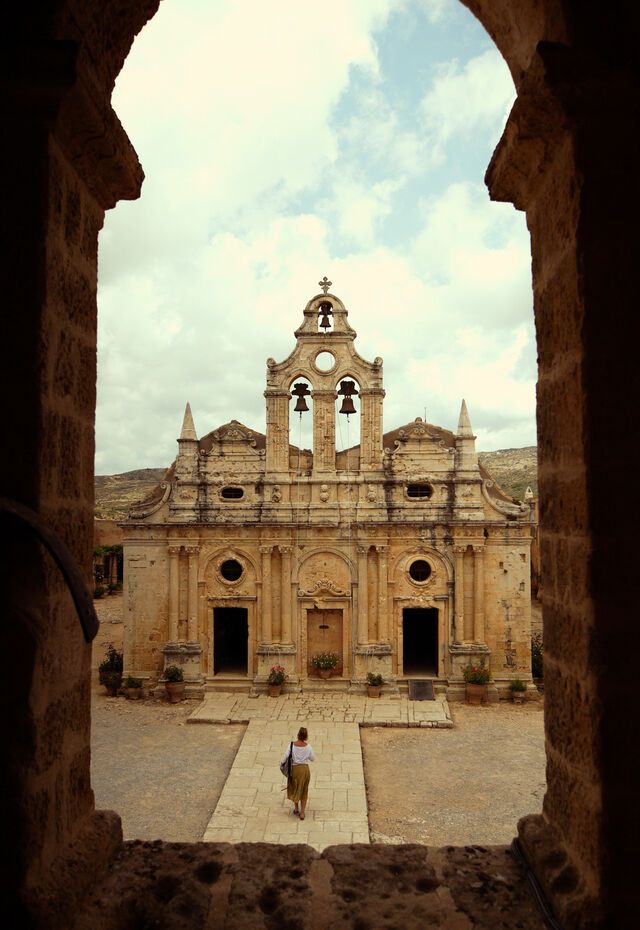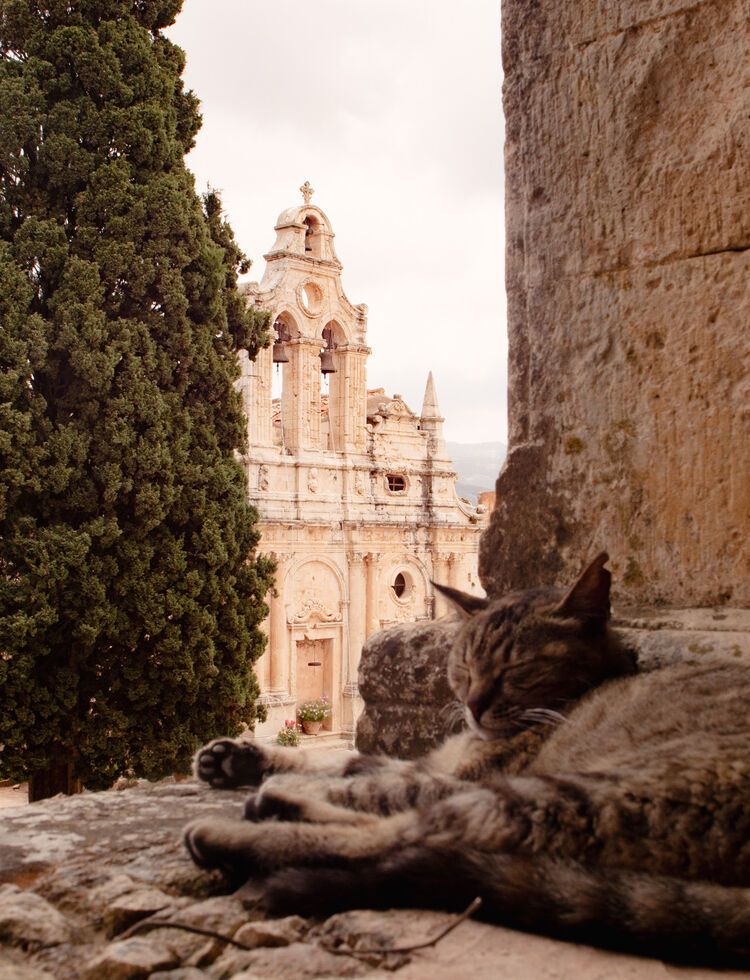A tour of the Monastery of Arkadi in Crete


OVERVIEW
Just 23km east of Rethymno, on a fertile plateau on the slopes of Mt Psiloritis, the Arkadi Monastery has an architecture and history that will captivate you. Several versions exist as to how it was founded, including the most prevalent that it was named after a monk named Arkadios who established a monastery made up of a small chapel and a few cells in the 11th century AD.
The current fortress-like structure (it’s referred to as a monastery-castle) was completed in the 16th century AD and a handful of monks still live in the cells and continue its work.
The Arkadi Monastery has a rich history. During the 16th and 17th centuries, it served as a centre of learning and copying manuscripts in Crete, and it housed a gold-embroidery workshop whose fabrics and vestments were sold to churches and monasteries around the world.
But most importantly, the monastery is a symbol of freedom and sacrifice, with Greek and international artists such as Theodoros Vryzakis and Giuseppe Lorenzo Gatteri creating masterpieces depicting the heroics of the 964 rebel fighters, women and children who barricaded themselves inside the convent while under siege by the occupying Ottomans in 1866, finally setting the gunpowder depot alight rather than surrender to the enemy.
The monastery is open to the public, welcoming visitors and pilgrims, as well as visitors who choose to stay overnight in its cells. If you are in or near Rethymno during your holidays in Crete, a visit to the monastery is a must, if only to feel its unique aura.
DON'T MISS
Highlights of the Arkadi Monastery
The Katholikon (main church)
In the heart of the monastery’s central courtyard (the Atrium) is the Katholikon (as the main church of Orthodox monasteries is often called), built in 1587 on the site of a smaller church and dedicated to Saint Constantine and Saint Helen as well as the Transfiguration of the Saviour Christ. The two-aisled basilica is a classic example of Renaissance architecture, courtesy of the Venetian presence in Crete at the time, and specifically influenced by the grand architectural minds of Sebastiano Serlio and Andrea Palladio. Around the perimeter of the courtyard, you will find monk’s cells and storage spaces.
The Altar (Dining Hall)
The Dining Hall is an indelible part of the Arkadi Monastery’s history. Built in 1687 on the north side of the monastery, it hasn’t changed since and is best known as the location of the massacre of 1866 when 36 young men were killed by Ottomans. You can still see some marks from bullets and swords on the wooden tables and chairs.
The Gunpowder Depot
The Gunpowder Depot was a domed, oblong structure that was destroyed by the explosion of 1866. The only part that remains intact now houses a wonderful painting by the artist Maravas, who was inspired by Theodore Vryzakis’ famous painting The Monastery of Arkadi, now kept at the National Gallery with a commemorative inscription about the event known as the Holocaust of the Arkadi Monastery.
The Museum
Close to the west gate, the Museum houses artefacts that trace the long history of the Arkadi Monastery, including manuscripts, holy fabrics and vestments, post-Byzantine icons and Greek Revolution-era weapons.
The Gallery
The Gallery houses artwork by older and more recent artists, who were inspired by the sacrifice during the siege, and other works depicting the historical and spiritual journey of the monastery through the centuries.
GET PLANNING
How do you get to Arkadi Monastery from Rethymno and Chania?
- The Arkadi Monastery is 35min (22km) by car from Rethymno and 1hr 20min (81km) or Chania by car.
- Alternatively, you can catch a bus from Rethymno or from Chania (changing at Rethymno).
Bus info from Rethymno & Chania
How do you get to Rethymno from the airport?
- Rethymno is approximately 1hr by car (72km) from Chania Airport and 1hr 15min (81km) by car from Heraklion Airport.
- You can get a bus to Rethymno from Chania Airport. From Heraklion Airport, you will first need to go to Heraklion Port and catch a bus to Rethymno from there.
When is the best time to visit Arkadi Monastery?
- The monastery is open to the public all year round.
- You can visit the Arkadi Monastery in Rethymno – and the island of Crete – at any time in the year, but you will enjoy it most in spring and autumn when the weather is milder and there are fewer people.
Discover Greece tip: If you go in July and August, morning or late afternoon is best.
- Autumn
- Spring
- Summer
- Winter
- It will take you about an hour to visit all the rooms and buildings of the monastery.
- Price of admission is €3 and free of charge for children under 16.
- Organised groups are eligible for a free-of-charge tour by a monk.
- Opening hours of the monastery and museum: Here
- There is a cafe right outside the monastery.
- There are several churches around the monastery.
- The nearby Arkadi Gorge has numerous hiking paths and the nearest settlement is the village of Amnatos.
- You can make a day of it by also visiting Ancient Eleftherna and strolling around the city of Rethymno.
- Please remember to dress appropriately for your visit to the monastery.



